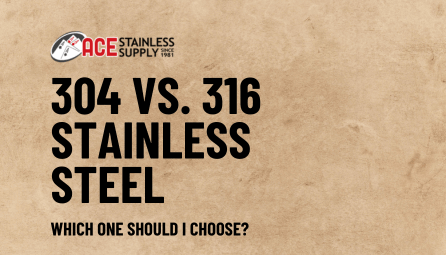Chemical Composition
The key difference between 304 and 316 stainless steel lies in their chemical makeup. Both are part of the austenitic family of stainless steels, known for their strength and corrosion resistance. 304 stainless steel contains approximately 18% chromium and 8–10.5% nickel, which gives it strong resistance to oxidation and corrosion in most environments. On the other hand, 316 stainless steel contains similar levels of chromium and nickel but includes an additional 2–3% molybdenum. This element significantly improves 316’s resistance to chlorides, acids, and harsh industrial chemicals.
Corrosion Resistance
Corrosion resistance is one of the most important factors when choosing between 304 and 316. While both alloys resist rust and oxidation well, 316 offers far superior protection against corrosion in aggressive environments. This makes it the preferred material for marine applications, coastal structures, and chemical processing equipment. In contrast, 304 is ideal for indoor or dry outdoor environments where exposure to corrosive elements is minimal. If you're building near the ocean or working with chlorinated solutions or acidic cleaners, 316 is the smarter choice for long-term durability.
Mechanical Properties and Strength
Both 304 and 316 offer excellent strength and durability, making them suitable for a wide range of structural and industrial applications. However, 316 has a slight edge in tensile and yield strength, and it retains its mechanical properties better under high temperatures and pressure. While both grades have good elongation and are relatively easy to form, 316 tends to be tougher to machine and cut due to its higher alloy content. For fabrication work where forming, drilling, or machining is involved, 304 may be a bit easier to work with but 316 will perform better in more demanding applications.
Heat and Chemical Resistance
If your application involves high temperatures or exposure to chemicals, 316 is the better option. The added molybdenum improves its resistance to chemical attack, especially in environments involving sulfuric acid, bromides, and other industrial compounds. While 304 can handle most oxidizing acids and sanitizing agents, it is more susceptible to pitting and crevice corrosion when exposed to salt or chloride-rich environments. For chemical plants, pharmaceutical processing, or marine systems, 316 provides the extra protection needed to maintain performance over time.
Magnetism
Both 304 and 316 stainless steels are non-magnetic in their annealed (heat-treated) state. However, they can become slightly magnetic when cold worked, such as through bending or stamping. This is more common in 304 than in 316. If non-magnetic properties are essential for example, in sensitive electronic or medical environments 316 tends to maintain its non-magnetic nature better under various fabrication methods.
Cost and Availability
One of the most noticeable differences is the cost. 316 stainless steel typically costs 20–30% more than 304 due to its higher nickel and molybdenum content. For budget-conscious projects where corrosion resistance isn’t a top concern, 304 is a reliable, cost-effective choice. However, if failure due to corrosion is a possibility, the additional investment in 316 can lead to significant long-term savings by reducing maintenance, repair, and replacement costs.
Common Applications
304 stainless steel is widely used in applications such as kitchen equipment, food processing surfaces, architectural paneling, automotive trim, and general industrial components. It offers great performance for indoor or mildly corrosive environments. In contrast, 316 is favored for harsh or corrosive conditions. It’s the go-to material for marine hardware, chemical processing tanks, pharmaceutical manufacturing equipment, and even surgical tools due to its biocompatibility.
Conclusion: Match the Grade to the Environment
Choosing between 304 and 316 stainless steel ultimately depends on your environment, application, and budget. If your project demands strong corrosion resistance and exposure to harsh chemicals or saltwater, 316 is worth the extra cost. For general-purpose, non-corrosive settings, 304 provides excellent value and durability. At Ace Stainless Supply, we carry both grades in a full range of products including sheet, plate, bar, and tube cut to your exact specifications. Contact our team today for expert guidance and fast, reliable stainless steel supply.

